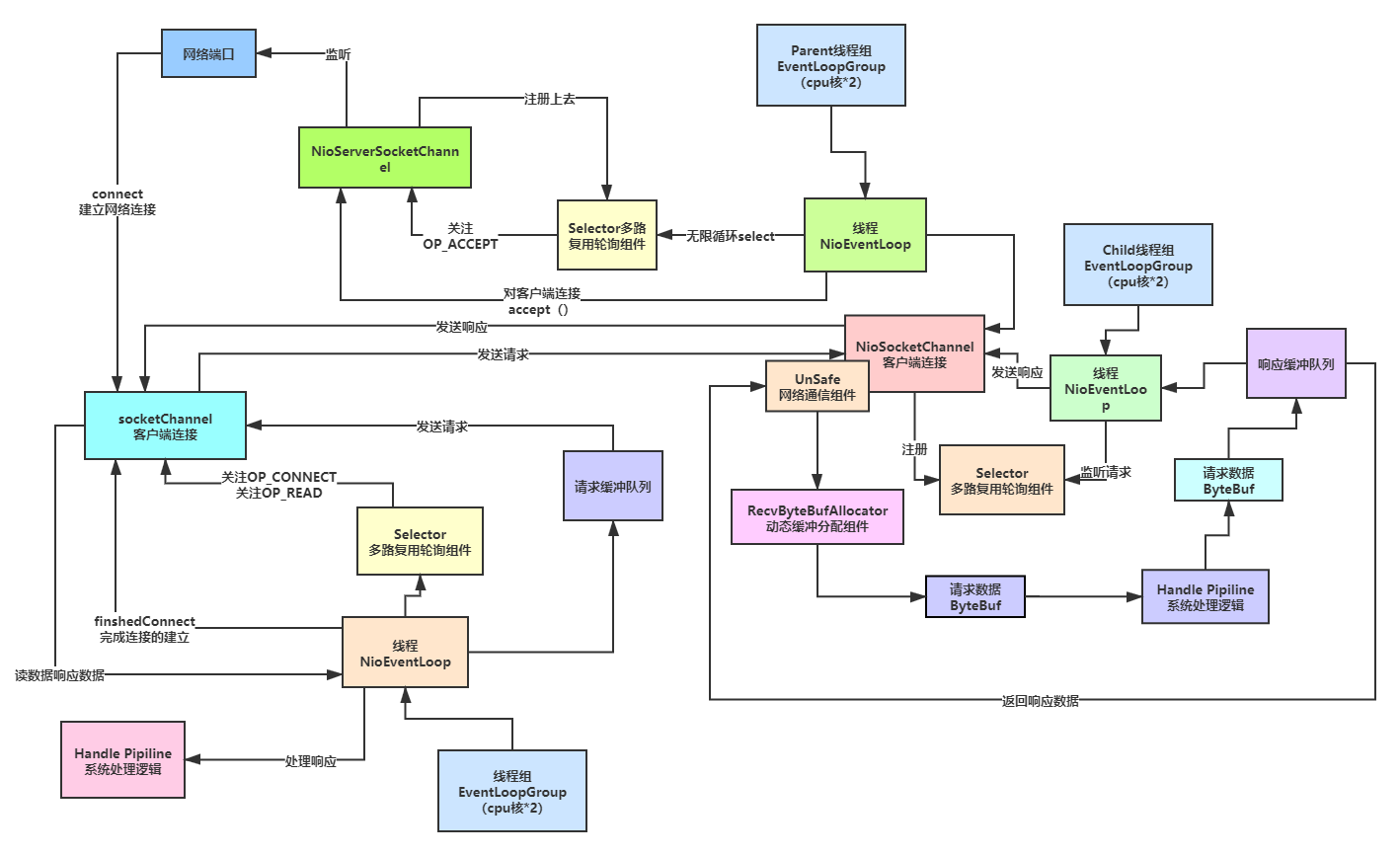文章目录
- 概念
- Pre
- 概述
- ByteBuf简介
- ByteBuf的主要特性
- 结构
- API
- ByteBuf的创建
- 读写操作示例
- 引用计数操作
- 其他常用操作
- Code 演示

概念

Pre
Netty Review - 探索ByteBuf的内部机制
概述
Netty的ByteBuf是一个强大的字节容器,用于处理字节数据。它提供了比Java标准库中的ByteBuffer更灵活和高效的方式来操作字节数据。
ByteBuf简介
Netty的ByteBuf是一个字节容器,它提供了一种更灵活和高效的方式来操作字节数据。与ByteBuffer不同,ByteBuf具有可扩展的缓冲区,可以动态调整容量,而不需要创建新的缓冲区对象。
ByteBuf的主要特性
- 可读性和可写性: ByteBuf具有读和写两种模式。读操作和写操作是相互独立的,因此可以在不同的操作中使用同一段数据。
- 零拷贝: ByteBuf支持零拷贝操作,这意味着可以直接操作底层内存,而无需将数据复制到中间缓冲区。
- 引用计数: ByteBuf使用引用计数来跟踪对缓冲区的活动引用,这有助于防止内存泄漏。
结构
ByteBuf有三个关键的指针,分别是readerIndex、writerIndex和capacity。
- readerIndex表示读操作的起始位置,
- writerIndex表示写操作的起始位置,
- capacity表示ByteBuf的容量

-
从结构上来说,ByteBuf 由一串字节数组构成。数组中每个字节用来存放信息。
-
ByteBuf 提供了两个索引,一个用于读取数据,一个用于写入数据。这两个索引通过在字节数组中移动,来定位需要读或者写信息的位置。
读写操作: 通过readerIndex和writerIndex来进行读写操作,支持顺序读写和随机读写
-
当从 ByteBuf 读取时,它的 readerIndex(读索引)将会根据读取的字节数递增。
-
同样,当写 ByteBuf 时,它的 writerIndex 也会根据写入的字节数进行递增。
-
需要注意的是极限的情况是 readerIndex 刚好读到了 writerIndex 写入的地方。 如果 readerIndex 超过了 writerIndex 的时候,Netty 会抛出 IndexOutOf-BoundsException 异常。
API
ByteBuf的创建
ByteBuf buffer = Unpooled.buffer(10); // 创建一个初始容量为10的ByteBuf
读写操作示例
// 写入数据
buffer.writeBytes("Hello".getBytes());// 读取数据
byte[] data = new byte[buffer.readableBytes()];
buffer.readBytes(data);
System.out.println(new String(data));
引用计数操作
// 引用计数 +1
buffer.retain();// 引用计数 -1,如果引用计数为0,则释放相关资源
buffer.release();
其他常用操作
- 获取和设置索引位置的字节值。
- 查找指定字节或字节数组的位置。
- 派发读/写索引而不实际移动数据。
Code 演示
import io.netty.buffer.ByteBuf;
import io.netty.buffer.Unpooled;
import io.netty.util.CharsetUtil;public class NettyByteBuf {public static void main(String[] args) {// 创建byteBuf对象,该对象内部包含一个字节数组byte[14]// 通过readerindex和writerIndex和capacity,将buffer分成三个区域// 已经读取的区域:[0,readerindex)// 可读取的区域:[readerindex,writerIndex)// 可写的区域: [writerIndex,capacity)ByteBuf byteBuf = Unpooled.buffer(14);System.out.println("byteBuf=" + byteBuf);printBytebuf(byteBuf);System.out.println("=================");for (int i = 0; i < 8; i++) {byteBuf.writeByte(i);}System.out.println("byteBuf=" + byteBuf);printBytebuf(byteBuf);System.out.println("=================");for (int i = 0; i < 5; i++) {System.out.println(byteBuf.getByte(i));}System.out.println("byteBuf=" + byteBuf);printBytebuf(byteBuf);System.out.println("=================");for (int i = 0; i < 5; i++) {System.out.println(byteBuf.readByte());}System.out.println("byteBuf=" + byteBuf);printBytebuf(byteBuf);System.out.println("=================");//用Unpooled工具类创建ByteBufString text = "hello,artisan!" ;ByteBuf byteBuf2 = Unpooled.copiedBuffer(text , CharsetUtil.UTF_8);//使用相关的方法if (byteBuf2.hasArray()) {byte[] content = byteBuf2.array();//将 content 转成字符串System.out.println(new String(content, CharsetUtil.UTF_8));System.out.println("byteBuf2=" + byteBuf2);printBytebuf(byteBuf2);System.out.println("=================");// 获取数组0这个位置的字符h的ascii码,h=104System.out.println(byteBuf2.getByte(0));System.out.println("=================");//可读的字节数 14int len = byteBuf2.readableBytes();System.out.println("len=" + len);printBytebuf(byteBuf2);System.out.println("=================");//使用for取出各个字节for (int i = 0; i < len; i++) {System.out.println((char) byteBuf2.getByte(i));}printBytebuf(byteBuf2);System.out.println("=================");//范围读取System.out.println(byteBuf2.getCharSequence(0, 6, CharsetUtil.UTF_8));printBytebuf(byteBuf2);System.out.println("=================");System.out.println(byteBuf2.getCharSequence(6, 8, CharsetUtil.UTF_8));printBytebuf(byteBuf2);}}public static void printBytebuf(ByteBuf byteBuf){System.out.println("readerIndex:" + byteBuf.readerIndex());System.out.println("writerIndex:" + byteBuf.writerIndex());System.out.println("capacity:" + byteBuf.capacity());}
}输出
byteBuf=UnpooledByteBufAllocator$InstrumentedUnpooledUnsafeHeapByteBuf(ridx: 0, widx: 0, cap: 14)
readerIndex:0
writerIndex:0
capacity:14
=================
byteBuf=UnpooledByteBufAllocator$InstrumentedUnpooledUnsafeHeapByteBuf(ridx: 0, widx: 8, cap: 14)
readerIndex:0
writerIndex:8
capacity:14
=================
0
1
2
3
4
byteBuf=UnpooledByteBufAllocator$InstrumentedUnpooledUnsafeHeapByteBuf(ridx: 0, widx: 8, cap: 14)
readerIndex:0
writerIndex:8
capacity:14
=================
0
1
2
3
4
byteBuf=UnpooledByteBufAllocator$InstrumentedUnpooledUnsafeHeapByteBuf(ridx: 5, widx: 8, cap: 14)
readerIndex:5
writerIndex:8
capacity:14
=================
hello,artisan!
byteBuf2=UnpooledByteBufAllocator$InstrumentedUnpooledUnsafeHeapByteBuf(ridx: 0, widx: 14, cap: 42)
readerIndex:0
writerIndex:14
capacity:42
=================
104
=================
len=14
readerIndex:0
writerIndex:14
capacity:42
=================
h
e
l
l
o
,
a
r
t
i
s
a
n
!
readerIndex:0
writerIndex:14
capacity:42
=================
hello,
readerIndex:0
writerIndex:14
capacity:42
=================
artisan!
readerIndex:0
writerIndex:14
capacity:42





)














